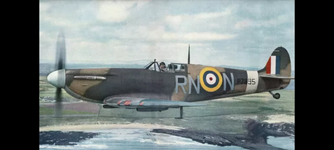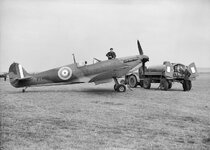Hi, I am new to this forum as I have failed in my search of this specific type. It is for the alternative variant of spinner used with the Rotol Jablo propellor on Spitfires, mainly MkIs and MkIIs. As far as I'm aware, all we have surviving for Rotol Jablo three blades are MkVs like Bm597.
Navigation
Install the app
How to install the app on iOS
Follow along with the video below to see how to install our site as a web app on your home screen.
Note: This feature may not be available in some browsers.
More options
You are using an out of date browser. It may not display this or other websites correctly.
You should upgrade or use an alternative browser.
You should upgrade or use an alternative browser.
Spitfire MkI/II Rotol Spinner, Blunt/Egg shape survivors?
- Thread starter SpitTyler
- Start date
Ad: This forum contains affiliate links to products on Amazon and eBay. More information in Terms and rules
More options
Who Replied?Geoffrey Sinclair
Staff Sergeant
- 1,104
- Sep 30, 2021
Information received,
1. There were two variants of the bulbous Spitfire spinner. Both were CSA designs/manufacture and not Rotol.
2. Manufacturer designation code which reflected design and construction methods-CSA= ES/#, Rotol =CM/#.
3. There are no probably surviving examples (a prop hub for the magnesium blade salvaged from a crash site has been measured).
4. The first variant, ES4, was for the magnesium blade.
5. The second variant, ES5, was for the wood blades which were first seen on some of the early Castle Bromwich Mk II's. Photographs suggest use up to and including the Mk V.
6. There were differences in the base plate layout and possibly the blade fillets and blade cut-outs in the spinner shell.
7. The pointed 'fighter' spinner (as Rotol termed it) was designed in early/mid 1940 but did not come into production until late 1940. Photographs suggest that this design was first fitted to the Hurricane (Mk I and II -CM1/ES/9) with a much later appearance on the Spitfire(ES11).
8. The spinner base diameter for the ES5 was identical to that of the later ES11. The unit was about 5 inches shorter.
P.S. The legend of the bulbous Spitfire spinners being used on the Hurricane during 1939/40 is probably incorrect.
1. There were two variants of the bulbous Spitfire spinner. Both were CSA designs/manufacture and not Rotol.
2. Manufacturer designation code which reflected design and construction methods-CSA= ES/#, Rotol =CM/#.
3. There are no probably surviving examples (a prop hub for the magnesium blade salvaged from a crash site has been measured).
4. The first variant, ES4, was for the magnesium blade.
5. The second variant, ES5, was for the wood blades which were first seen on some of the early Castle Bromwich Mk II's. Photographs suggest use up to and including the Mk V.
6. There were differences in the base plate layout and possibly the blade fillets and blade cut-outs in the spinner shell.
7. The pointed 'fighter' spinner (as Rotol termed it) was designed in early/mid 1940 but did not come into production until late 1940. Photographs suggest that this design was first fitted to the Hurricane (Mk I and II -CM1/ES/9) with a much later appearance on the Spitfire(ES11).
8. The spinner base diameter for the ES5 was identical to that of the later ES11. The unit was about 5 inches shorter.
P.S. The legend of the bulbous Spitfire spinners being used on the Hurricane during 1939/40 is probably incorrect.
- Thread starter
- #4
Well I thank you shedding some light on the subject with great specifics. It is a shame there are likely no surviving examples but it is odd how, despite their mass produce, none are seen today. They only exist in period photographs, digital games and models. I'm not sure if there even any replicas of the typeInformation received,
1. There were two variants of the bulbous Spitfire spinner. Both were CSA designs/manufacture and not Rotol.
2. Manufacturer designation code which reflected design and construction methods-CSA= ES/#, Rotol =CM/#.
3. There are no probably surviving examples (a prop hub for the magnesium blade salvaged from a crash site has been measured).
4. The first variant, ES4, was for the magnesium blade.
5. The second variant, ES5, was for the wood blades which were first seen on some of the early Castle Bromwich Mk II's. Photographs suggest use up to and including the Mk V.
6. There were differences in the base plate layout and possibly the blade fillets and blade cut-outs in the spinner shell.
7. The pointed 'fighter' spinner (as Rotol termed it) was designed in early/mid 1940 but did not come into production until late 1940. Photographs suggest that this design was first fitted to the Hurricane (Mk I and II -CM1/ES/9) with a much later appearance on the Spitfire(ES11).
8. The spinner base diameter for the ES5 was identical to that of the later ES11. The unit was about 5 inches shorter.
P.S. The legend of the bulbous Spitfire spinners being used on the Hurricane during 1939/40 is probably incorrect.
SpitTyler,
A restorer was asking the same question as yourself about a decade ago for the BBMF MkIIa Spit but there is very little information out there and no surviving examples unfortunately which is a shame, especially when we have so many BofB Hurricanes either flying or under restoration to fly at the moment, they would look so much more period with the blunt spinners rather than the later pointed Rotol.
Geoffrey, that is some good information there, may I ask who 'CSA' was please?
A restorer was asking the same question as yourself about a decade ago for the BBMF MkIIa Spit but there is very little information out there and no surviving examples unfortunately which is a shame, especially when we have so many BofB Hurricanes either flying or under restoration to fly at the moment, they would look so much more period with the blunt spinners rather than the later pointed Rotol.
Geoffrey, that is some good information there, may I ask who 'CSA' was please?
- Thread starter
- #6
Exactly what I was thinking and with P7350 with the MkV rotol propellor and spinner, which apparently has had the spinner since the end of the war but for other spits that were only "a few doors down" on the production line and had blunt spinners such as P7420. Rotol prop spits were made at Castle Bromwich whereas DH prop spits were made in Southampton.SpitTyler,
A restorer was asking the same question as yourself about a decade ago for the BBMF MkIIa Spit but there is very little information out there and no surviving examples unfortunately which is a shame, especially when we have so many BofB Hurricanes either flying or under restoration to fly at the moment, they would look so much more period with the blunt spinners rather than the later pointed Rotol.
Geoffrey, that is some good information there, may I ask who 'CSA' was please?
Snautzer01
Marshal
- 46,292
- Mar 26, 2007
CSA = Constant Speed Airscrews ltd. i think.SpitTyler,
A restorer was asking the same question as yourself about a decade ago for the BBMF MkIIa Spit but there is very little information out there and no surviving examples unfortunately which is a shame, especially when we have so many BofB Hurricanes either flying or under restoration to fly at the moment, they would look so much more period with the blunt spinners rather than the later pointed Rotol.
Geoffrey, that is some good information there, may I ask who 'CSA' was please?
Geoffrey Sinclair
Staff Sergeant
- 1,104
- Sep 30, 2021
More information received. To confirm. CSA is an abbreviation of Constant Speed Airscrews Ltd of Warwick. This company manufactured propeller spinners which incorporated (under license) the VDM locking system (yes, as used for example on the Me 109). The spinner codes relate to the Company and certain design characteristics. Very simply, ES = CSA, CM = Rotol.
Users who are viewing this thread
Total: 1 (members: 0, guests: 1)
Similar threads
- Replies
- 0
- Views
- 1K


